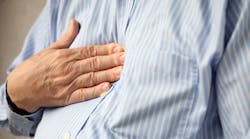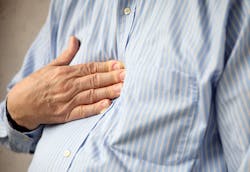Taking Off My Blinders About Gerd
By JUDITH M. STEIN, RDH
While conducting an intraoral exam, who else has observed permanent molars with extreme occlusal wear? Cusps with significant vertical loss. It’s never pretty, and my stomach sinks while viewing damaged posterior occlusal surfaces. I would imagine every dental care provider has also observed this described oral condition countless times in their careers. You may even subconsciously begin looking for patterns of bruxism, evaluate for TMJ distress, assess oral malocclusion, or scour tissue for gingival abfractions.
Life recently forced me to pitch off my self-imposed blinders, allowing a new thought protocol to emerge. When posterior occlusal enamel wear presents itself, I now refer back to the patient’s medical history for GERD medications or acid reflux symptoms, as well as signs of bruxism. Truth is, if I didn’t see obvious anterior lingual wear on enamel, I assumed posterior occlusal loss and erosion was always due to other oral issues. My life, though, has spun me out of a tunnel to cast new light into my dental portfolio of care.
We shine a light on the medical condition of gastroesophageal reflux disease (GERD). Acid reflux. Heartburn. All three phrases are commonly used to describe the passage of gastric/stomach contents into the esophagus. Left untreated, this condition can cause serious inflammation and damage to the lining of the esophagus. Unfortunately, GERD can also roar along a very sneaky, destructive path into the oral cavity as well.
Over several years, I have witnessed two family members suffer from this painful and destructive condition. I’d like to say I was quick to notice all the subtle oral signs and symptoms of their challenges during these trials. Sadly, I did not. Over time, gastric acid not only scoured their esophagi but also caused significant damage to tooth enamel — specifically, posterior occlusal wear. It’s become personal for me, and I’d like to make it personal for you too.
Before I proceed with the oral manifestations, research, diagnosis, and management of GERD, I’d like to review the general health specifics of this condition. As defined by the Mayo Clinic online resource site, “Gastroesophageal reflux disease (GERD) is a chronic digestive disease that occurs when stomach acid or, occasionally, bile flows back (refluxes) into your food pipe (esophagus). The backwash of acid irritates the lining of your esophagus and causes GERD signs and symptoms.”
Although many words in that definition cause me great concern, what stands out to me now is the word chronic. Chronic is usually defined as “continuing a long time or recurring frequently.” Unfortunately, those who suffer from GERD may exhibit symptoms for lengthy periods of time before the horrid oral effects of this condition become obvious.
The following is a condensed list of signs and symptoms of GERD gathered from the Mayo Clinic’s online resources:
A burning sensation in your chest (heartburn), sometimes spreading to the throat, along with a sour taste in your mouth
- Chest pain
- Difficulty swallowing (dysphagia)
- Dry cough
- Hoarseness or sore throat
- Regurgitation of food or sour liquid (acid reflux)
- Sensation of a lump in the throat
I now wish I could have seen more clearly the onset of GERD symptoms among my family members. Sadly, it was a very confusing time for both patient and health-care provider. In the beginning of this journey, symptoms of stress, anxiety, and weight loss were also communicated. Yes, as the condition worsened, more obvious symptoms occurred to help with the diagnosis.
What I wonder, as a dental health professional, is could I have picked up on those subtle signs more readily and much sooner? Looking at the above list of seven symptoms, five of them have direct oral implications. I should have known better. I can do better!
The University of Michigan Medical Online Resources also elaborates on the physiological process of GERD. Several research articles note that “the lower esophageal sphincter muscle, when functioning correctly, allows food to enter the stomach and then closes off. This action establishes a sealed environment for the digestive process to occur. When a person experiences gastroesophageal distress, however, this muscle does not close off properly, allowing acid and/or bile to re-enter the esophagus, causing much pain.”
The National Library of Medicine has an excellent online resource that highlights additional research on the topic of oral complications for those who suffer from the effects of GERD. In January 2012, the dental school at the University of Adelaide in Australia concluded, “Numerous case-control and other studies involving confirmation of gastroesophageal reflux disease (GERD) by esophageal pH-metry and the assessment of dental erosions have shown significant associations between the two conditions in both adults and children.” What is also noted in this abstract is that 42% of physicians strongly agreed that such an association between GERD and dental erosions existed in adults, and just 12.5% strongly agreed for children.
Due to our vantage point and access to the oral cavity, dental providers must remain on the lookout for GERD signs and symptoms. We could be the first to unravel this condition for our patients or become adjuncts in their maintenance of care. Either scenario will provide enormous relief to those who suffer from GERD and possibly help save tooth enamel in the process.
In addition, the Journal of the American Dental Association has several research articles affirming palatal and lingual enamel loss in patients suffering from GERD. What I found surprising was the additional location of enamel erosion caused from stomach acid. Their findings concluded that “occlusal surfaces of posterior teeth often show significant enamel wear from this sometimes silent and destructive condition.”
In the past, when I visualized the path of acid destruction, I most often saw this occurring on palatal and lingual tooth surfaces. When I saw posterior occlusal wear on teeth, I most often considered bruxism and not GERD. Both my family members who suffer from GERD exhibit occlusal wear on their posterior molars. I suspected bruxism and never connected this wear to the subtle signs of GERD.
I now evaluate anyone who presents with occlusal wear very differently. Yes, I still gather information to evaluate possible bruxism symptoms. Yes, I still see the enormous benefit an occlusal bite guard can provide. The difference is that I now also evaluate for GERD signs and symptoms.
It is important to note that not every person suffering from GERD symptoms will present with enamel loss, but I encourage dental professionals to join me in evaluating this condition differently (see sidebar for additional information).
The management of GERD is a very sensitive journey and is patient specific. Walking alongside your patients, becoming knowledgeable of their conditions, making simple allowances to provide comfortable care, and making sure your blinders are off will offer enormous support to any patient living with GERD. Whenever respect, knowledge, and understanding are shared, healing begins, and healing can continue. RDH
The Comfort Level For GERD Dental Patients
When reviewing your patient’s medical history, look for medications such as Tagamet, Pepcid, Prevacid or Prilosec that are known to reduce the amount of acid in the stomach. Some naturopathic choices to manage symptoms of GERD include aloe vera juice, herbal licorice root, or betaine HCL supplement. Regardless of the treatment choices a patient makes, you will now be better able to evaluate your patient’s oral condition from a broader perspective and awareness of all treatment options.
You may also need to make minor adjustments while treating your patient. Be cognizant of their reclining posture in the dental chair. Most GERD patients need to sleep in a semi-reclined state. Depending on the time of day, and if the patient has consumed a meal recently, they may ask to not be reclined fully. Please make allowance for this. GERD is a painful, miserable, and very sensitive condition.
Some patients may even request you not use mint-flavored prophy paste while polishing. Mint products are known to cause a more relaxed state in the esophageal sphincter. When that muscle relaxes, it may allow acid or bile to seep up the esophagus, triggering other GERD symptoms. Don’t hesitate to educate your patient regarding toothpaste choices that could trigger this reaction. Be proactive. Do some research on this subject and have specific toothpaste brands ready to recommend that are not mint flavored. Anyone suffering from this condition is on heightened awareness of everything they consume, even trace amounts of mint found in toothpaste. Your efforts will be greatly appreciated.
JUDITH M. STEIN, RDH, is a 1981 graduate of Kellogg Community College in Battle Creek, Mich. Judy has enjoyed a variety of professional opportunities in her hygiene career, is committed to lifelong learning, and is now employed in private practice. The author is an active volunteer in several professional, community, and faith organizations. She can be reached at [email protected].
Past RDH Issues







